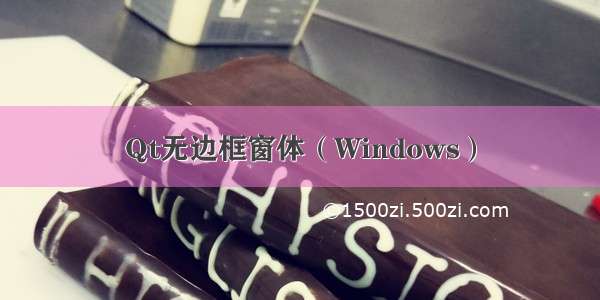
在使用QT创建窗体的时候,为了使窗口美化,通常不使用QT自带的边框。会调用下面函数去除窗体边框。
setWindowFlags(Qt::FramelessWindowHint)
但是有个问题,当去除了QT自带边框后,窗体就变得不能移动了,也不能改变窗口大小了。这确实是个问题,该怎么去解决呢?
首先我们来解决窗口移动的问题:解决思路就是在鼠标按下事件中记录按下的位置QPoint pLast, 并标记鼠标状态m_bPressed = true; 为按下状态。
void MainWindow::mousePressEvent(QMouseEvent *event){this->setFocus();if(Qt::LeftButton == event->button() && 0 == (Qt::WindowMaximized & this->windowState())){QPoint temp=event->globalPos();pLast=temp;//记录鼠标按下的位置event->ignore();}m_bPressed = true; //标记鼠标为按下状态}
然后在鼠标移动事件中进行窗体移动
void MainWindow::mouseMoveEvent(QMouseEvent * event){if(this->isMaximized()) //如果当前是最大化,则不允许移动return; if((event->buttons() & Qt::LeftButton) && m_bPressed)//是否左击{QPoint ptemp=event->globalPos();//当前鼠标全局位置ptemp=ptemp-pLast;//计算移动变量ptemp=ptemp+pos();//窗口原始位置(pos()) + 鼠标移动变量(ptemp) = 最终窗口位置move(ptemp);//移动窗口到新的位置}}
最后需要在鼠标松开事件中进行状态复位
void MainWindow::mouseReleaseEvent(QMouseEvent * event){QApplication::restoreOverrideCursor();//恢复鼠标指针性状event->ignore();m_bPressed = false;}
到这里,就已经全部解决了无边框窗口可以动的问题。但是,但是我们窗口拉伸缩放,进行调节窗口大小的问题还没有解决,这里该怎么解决呢?首先我们将窗口的区域进行划分,如下图
这里我们将一个窗口划分为9个区域,分别为
左上角(1,1)、中上(1,2)、右上角(1,3)
左中(2,1)、 中间(2,2)、右中 (2,3)
左下角(3,1)、中下(3,2)、 右下角(3,3)
思路应该是这样:
1.当鼠标移动时候,我们首先判断这个光标处于哪个区域
2.当鼠标移动到不同区域,鼠标的形状是不同变化的。
3.根据(2,2)之外的区域,计算初鼠标移动的偏移量,来重新设置窗口的坐标。
比如,鼠标进入区域(2,2)的时候,说明是移动窗口的操作,而不是进行窗口缩放的操作。除了区域(2,2)之外,其他8个区域均是进行窗口缩放的,但是处于不同区域内,鼠标的形状是不一样。
看代码
void MainWindow::mouseMoveEvent(QMouseEvent * event){if(this->isMaximized()) //如果最大化,则不允许移动和拉伸return;int poss=countFlag(event->pos(),countRow(event->pos()));//计算出来鼠标在哪个区域if(!event->buttons())setCursorType(poss);//根据不同的区域设置不同的鼠标形状if((event->buttons() & Qt::LeftButton) && m_bPressed)//是否左击{QPoint ptemp=event->globalPos();ptemp=ptemp-pLast; //鼠标移动的偏移量if(m_curPos==22) //区域(2,2)表示移动窗口{ptemp=ptemp+pos();move(ptemp);}else{QRect wid=geometry();int minWidth = this->minimumWidth();int minHeight = this->minimumHeight();switch(m_curPos)//改变窗口的大小{case 11:{QPoint pos = wid.topLeft();if(wid.width() > minWidth || ptemp.x() < 0)pos.rx() = pos.rx() + ptemp.x();if(wid.height() > minHeight || ptemp.y() < 0)pos.ry() = pos.ry() + ptemp.y();wid.setTopLeft(pos);break;//左上角}case 13:{QPoint pos = wid.topRight();if(wid.width() > minWidth || ptemp.x() > 0)pos.rx() = pos.rx() + ptemp.x();if(wid.height() > minHeight || ptemp.y() < 0)pos.ry() = pos.ry() + ptemp.y();wid.setTopRight(pos);break;//右上角}case 31:{QPoint pos = wid.bottomLeft();if(wid.width() > minWidth || ptemp.x() < 0)pos.rx() = pos.rx() + ptemp.x();if(wid.height() > minHeight || ptemp.y() > 0)pos.ry() = pos.ry() + ptemp.y();wid.setBottomLeft(pos);break;//左下角}case 33:{QPoint pos = wid.bottomRight();if(wid.width() > minWidth || ptemp.x() > 0)pos.rx() = pos.rx() + ptemp.x();if(wid.height() > minHeight || ptemp.y() > 0)pos.ry() = pos.ry() + ptemp.y();wid.setBottomRight(pos);break;//右下角}case 12:{int topY = wid.top();if(wid.height() > minHeight || ptemp.y() < 0)topY = topY + ptemp.y();wid.setTop(topY);break;//中上角}case 21:{int leftX = wid.left();if(wid.width() > minWidth || ptemp.x() < 0)leftX = leftX + ptemp.x();wid.setLeft(leftX);break;//中左角}case 23:{int rightX = wid.right();if(wid.width() > minWidth || ptemp.x() > 0)rightX = rightX + ptemp.x();wid.setRight(rightX);break;//中右角}case 32:{int botY = wid.bottom();if(wid.height() > minHeight || ptemp.y() > 0)botY = botY + ptemp.y();wid.setBottom(botY);break;//中下角}}setGeometry(wid); //设置窗口的位置}pLast=event->globalPos();//更新位置}event->ignore();}
计算鼠标在哪个区域
int MainWindow::countFlag(QPoint p,int row)//计算鼠标在哪一列和哪一行{if(p.y()<MARGIN)return 10+row;else if(p.y()>this->height()-MARGIN)return 30+row;elsereturn 20+row;}
根据鼠标所在位置改变鼠标形状
void MainWindow::setCursorType(int flag)//根据鼠标所在位置改变鼠标指针形状{Qt::CursorShape cursor;switch(flag){case 11:case 33:cursor=Qt::SizeFDiagCursor;break;case 13:case 31:cursor=Qt::SizeBDiagCursor;break;case 21:case 23:cursor=Qt::SizeHorCursor;break;case 12:case 32:cursor=Qt::SizeVerCursor;break;case 22:cursor=Qt::ArrowCursor;break;default:// QApplication::restoreOverrideCursor();//恢复鼠标指针性状break;}setCursor(cursor);}
到这里,就可以正常的进行窗口拉伸进行窗口缩放了。
截止现在,已经完成了一个可拉伸,可移动的无边框窗口。
这里还有个隐患,就是设置了无边框窗口之后,里面的内容就不会及时刷新了
setWindowFlags(Qt::FramelessWindowHint)
我们应该怎么做呢?需要重写显示事件
void MainWindow::showEvent(QShowEvent* event){this->setAttribute(Qt::WA_Mapped);//解决不能及时刷新的bugQMainWindow::showEvent(event);}
这里就完美的解决了所有的问题。
我这里做了一个demo,/download/xiezhongyuan07/10390321














